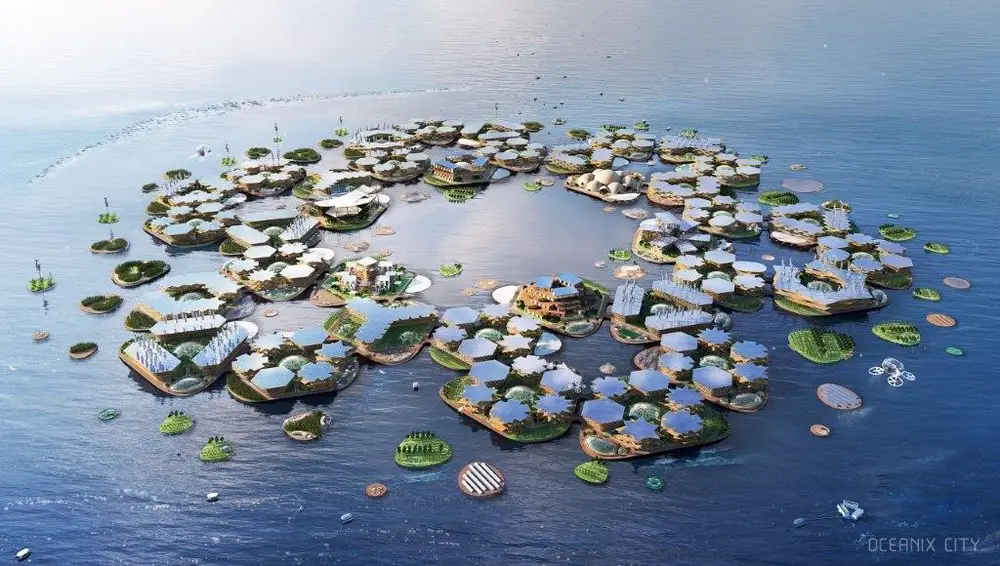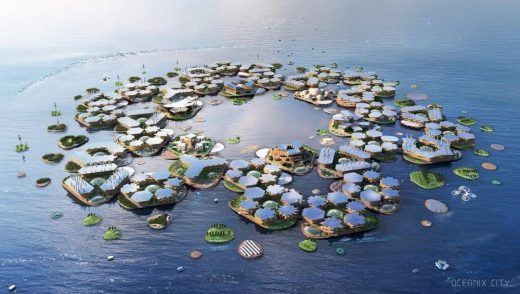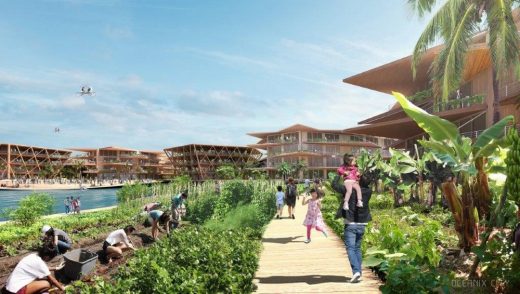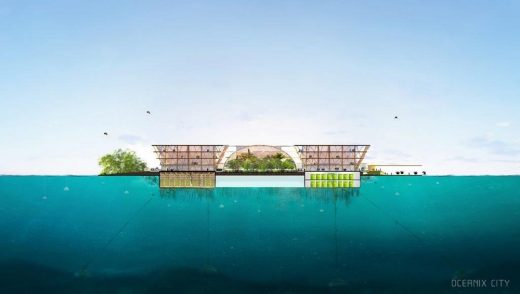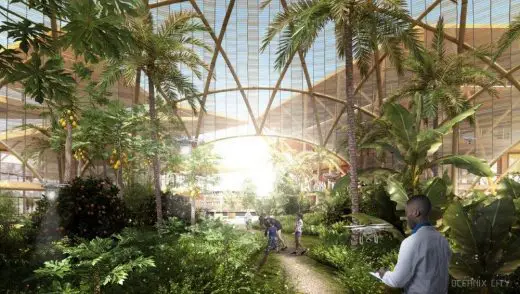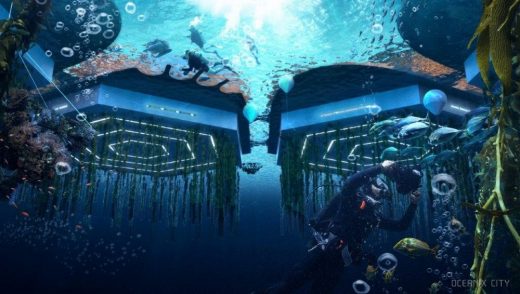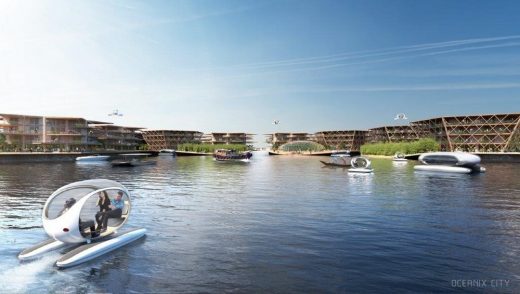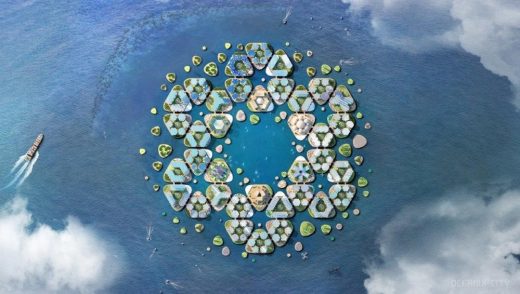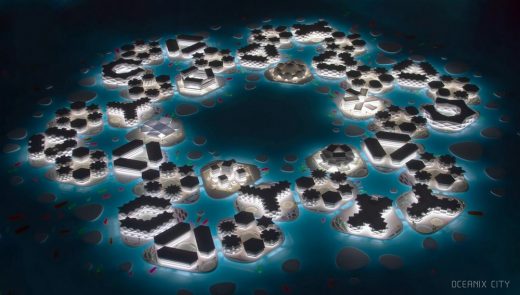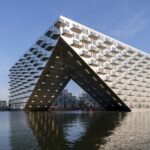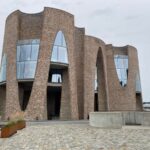Oceanix City by BIG, UN Sustainable Floating City by Bjarke Ingels Architect, BIG Architecture Images
Oceanix City by BIG: Floating Cities
UN-Habitat New Urban Agenda: Architecture design by BIG-Bjarke Ingels Group Architects
5 Apr 2019
Oceanix City design by BIG, UN Sustainable Floating Cities
Images by BIG-Bjarke Ingels Group
As part of UN-Habitat’s New Urban Agenda, floating cities non-profit OCEANIX, the MIT Center for Ocean Engineering, BIG and partners propose a vision for the world’s first resilient and sustainable floating community for 10,000 residents: Oceanix City.
BIG AND PARTNERS UNVEIL OCEANIX CITY AT THE UNITED NATIONS
The first UN high-level roundtable on Sustainable Floating Cities brought together innovators, explorers, marine engineers and scientists at the UN Headquarters to share ideas and solutions to the threats faced by coastal cities and countries due to rising sea levels. The roundtable was co-convened by OCEANIX, the MIT Center for Ocean Engineering, The Explorers Club and BIG.
“We are the UN agency mandated to work with cities, be they on land or water. We are ready to engage in dialogue on Sustainable Floating Cities to ensure this burgeoning sector is mobilized to good effect and for the benefit of all people.” Maimunah Mohd Sharif, the Executive Director of UN-Habitat and UN Under Secretary-General.
By 2050, 90% of the world’s largest cities will be exposed to rising seas. The vast majority of coastal cities will be impacted by coastal erosion and flooding, displacing millions of people, while destroying homes and infrastructure. Marc Collins Chen, Co-Founder and CEO of OCEANIX, said humans can live on floating cities in harmony with life below water. “It is not a question of one versus the other. The technology exists for us to live on water, without killing marine ecosystems. It is our goal to make sure sustainable floating cities are affordable and available to all coastal areas in need. They should not become a privilege of the rich.”
Designed as a man-made ecosystem, Oceanix City is anchored in the UN Sustainable Development Goals, channeling flows of energy, water, food and waste to create a blueprint for a modular maritime metropolis.
“9 out of 10 of the world’s largest cities will be exposed to rising seas by 2050. The sea is our fate – it may also be our future. The first sustainable and self-sustained floating community Oceanix City is designed as a human-made ecosystem channeling circular flows of energy, water, food and waste. Oceanix City is a blueprint for a modular maritime metropolis anchored in the UN’s Sustainable Development Goals.
The additive architecture can grow, transform and adapt organically over time, evolving from a neighborhood of 300 residents to a city of 10,000 – with the possibility of scaling indefinitely to provide thriving nautical communities for people who care about each other and our planet.”
Bjarke Ingels, Founding Partner, BIG-Bjarke Ingels Group.
Oceanix City is designed to grow, transform and adapt organically over time, evolving from neighborhoods to cities with the possibility of scaling indefinitely. Modular neighborhoods of 2 hectares create thriving self-sustaining communities of up to 300 residents with mixed-use space for living, working and gathering during day and night time. All built structures in the neighborhood are kept below 7 stories to create a low center of gravity and resist wind. Every building fans out to self-shade internal spaces and public realm, providing comfort and lower cooling costs while maximizing roof area for solar capture.
Communal farming is the heart of every platform, allowing residents to embrace sharing culture and zero waste systems. Below sea level, beneath the platforms, biorock floating reefs, seaweed, oysters, mussel, scallop and clam farming clean the water and accelerate ecosystem regeneration.
By clustering six neighborhoods around a protected central harbor, larger villages of 12 hectares can accommodate up to 1,650 residents. Social, recreational and commercial functions are placed around the sheltered inner ring to encourage citizens to gather and move around the village. Residents can easily walk or boat through the city using electric vehicles.
Aggregating to reach a critical density, six villages connect to form a city of 10,000 residents with a strong sense of community and identity. A larger protected harbor is formed in the heart of the city. Floating destinations and art, including six specialized landmark neighborhoods with a public square, market place and centers for spirituality, learning, health, sport and culture create destinations drawing residents from across the city and anchoring each neighborhood in a unique identity. All communities regardless of size will prioritize locally sourced materials for building construction, including fast-growing bamboo that has six times the tensile strength of steel, a negative carbon footprint, and can be grown on the neighborhoods themselves.
Floating cities can be prefabricated on shore and towed to their final site, reducing construction costs. Pairing this with the low cost of leasing space on the ocean creates an affordable model of living. These factors mean that affordable housing can be rapidly deployed to coastal megacities in dire need. The first Oceanix Cities are calibrated for the most vulnerable tropical and sub-tropical regions around the globe.
Oceanix City by BIG, UN Sustainable Floating Cities – Building Information
CLIENT: OCEANIX
SIZE: 75 hectares
COLLABORATORS: MIT Center for Ocean Engineering, Mobility in Chain, Sherwood Design Engineers, Center for Zero Waste Design, Transsolar KlimaEngineering, Global Coral Reef Alliance, Studio Other Spaces (Olafur Eliasson and Sebastian Behmann), Dickson Despommier
BIG–BJARKE INGELS GROUP
Partners-in-Charge: Bjarke Ingels, Daniel Sundlin
Project Leaders: Alana Goldweit, Jeremy Alain Siegel
Team: Andy Coward, Ashton Stare, Autumn Visconti, Bernardo Schuhmacher, Carlos Castillo, Cristina Medina-Gonzalez, Jacob Karasik, Kristoffer Negendahl, Mai Lee, Manon Otto, Terrence Chew, Thomas McMurtrie, Tore Banke, Tracy Sodder, Walid Bhatt, Will Campion, Yushan Huang, Tore Banke, Ziyu Guo
Oceanix City by BIG, UN Sustainable Floating Cities images / information from BIG New York 040419
Location: any ocean
Marine Buildings
Contemporary Marine Architecture
Energy Island : Sustainable Maritime Architecture
Dutch Maritime Network : design by Monolab, architects
Marine Technology Research Centre
Design: Snøhetta, architects
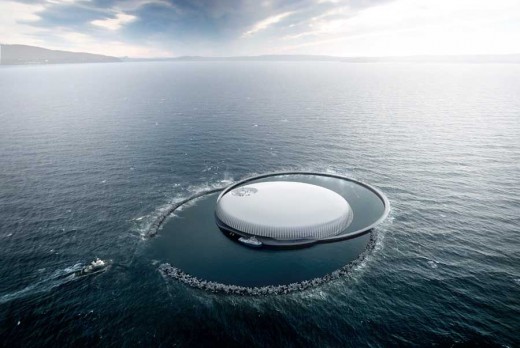
image : MIR
Marine Technology Research Centre
Marine Research Center Bali
Design: solus4 ; Design Principal: Mr. Alfonso Lopez LEED AP
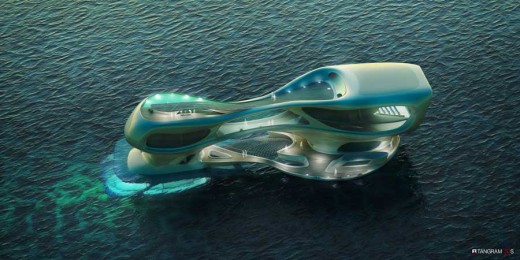
image : Tangram 3DS LLC
Marine Research Center Bali
Submarine Competition
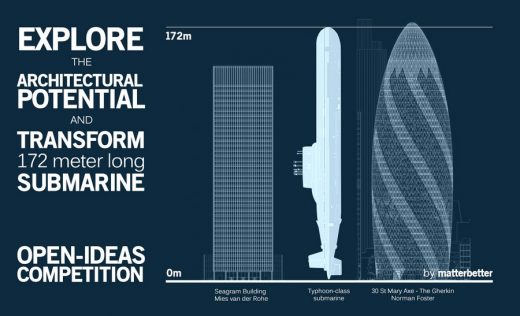
image courtesy of architects
Submarine Design Competition
Ocean Platform Prison Competition
Ocean Architecture Competition
American Spaceport by Foster + Partners
Floating Sauna in Norway by Casagrande & Rintala
Comments / photos for this Oceanix City by BIG, UN Sustainable Floating Cities page welcome
Website: Andermatt Switzerland

